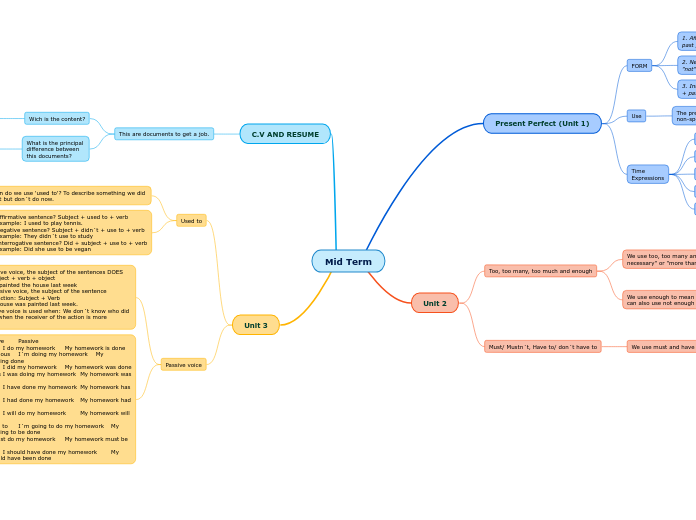Mid Term
Unit 3
Passive voice
Tense Active Passive
Present Simple I do my homework My homework is done
Present Continuous I´m doing my homework My homework is being done
Past Simple I did my homework My homework was done
Past Continuous I was doing my homework My homework was being done
Present Perfect I have done my homework My homework has been done
Past Perfect I had done my homework My homework had been done
Future simple I will do my homework My homework will be done
Future Be going to I´m going to do my homework My homework is being to be done
Modal I must do my homework My homework must be done
Modal Perfect I should have done my homework My homework should have been done
• In the active voice, the subject of the sentences DOES the action: Subject + verb + object
Example: John painted the house last week
• In the passive voice, the subject of the sentence RECEIVES the action: Subject + Verb
Example: The house was painted last week.
• The passive voice is used when: We don´t know who did the action and when the receiver of the action is more important.
Used to
Affirmative sentence? Subject + used to + verb
Example: I used to play tennis.
Negative sentence? Subject + didn´t + use to + verb
Example: They didn´t use to study
Interrogative sentence? Did + subject + use to + verb
Example: Did she use to be vegan
• When do we use 'used to'? To describe something we did in the past but don´t do now.
C.V AND RESUME
This are documents to get a job.
What is the principal difference between this documents?
The extension, the C.V is more extense than the resume.
Wich is the content?
-Studies of the person
-Habilities of the person
-Laboral experience of the person
Unit 2
Must/ Mustn´t, Have to/ don´t have to
We use must and have to to talk about obligations and rules
We use don´t have to to say that something isn´t necessary.
We use mustn´t to talk about thing are not allowed.
When we ask questions about obligations and rules, we usually use have to
Too, too many, too much and enough
We use enough to mean "the right amount" or "sufficient". We can also use not enough to mean "less than necessary"
Enough comes after an adjective or adverb
We use too, too many and too much to mean "more than necessary" or "more than is good".
We use too much before uncountable nouns
We use too many before countable nouns
We use too before adjectives and adverbs
Present Perfect (Unit 1)
Time Expressions
Just: "He has just called."
Yet: "I haven´t finished yet"
For: "I haven´t seen him for two years"
Since: "I haven´t seen Lazy since 2004"
Already: "She has already sent an email to the manager"
Use
The present perfect tense is used for actions that ocurred at a non-specific time before now. Specific time is not important.
FORM
3. Interrogative Sentences: Auxiliar verb (to have) + subject + past participle. Example: "Have you talked to Peter?"
2. Negative Sentences: Subject + auxiliar verb (to have) + "not" + past participle. Example: "I haven´t talked to Peter"
1. Affirmative Sentences: Subject + auxiliar verb (to have) + past participle. Example: "I have talked to peter"

